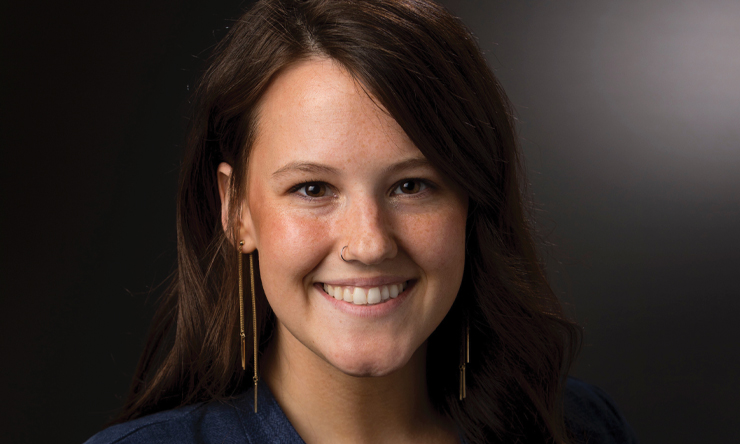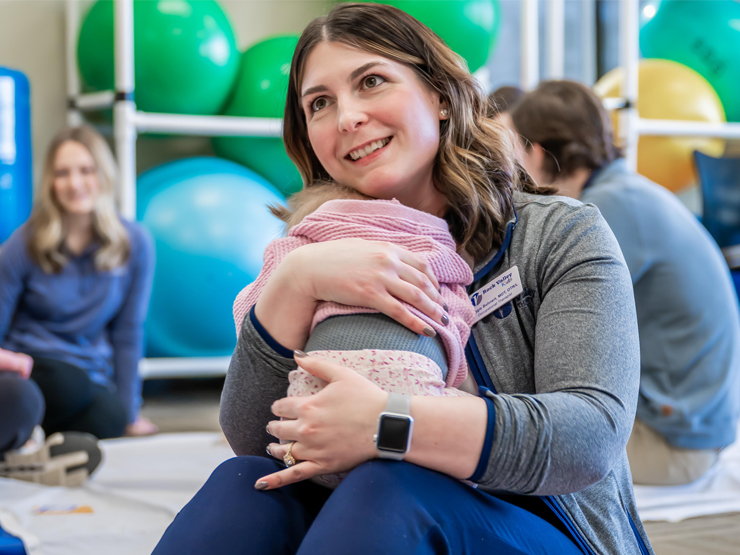The oak is a slow growing tree, often needing three or more decades before it can begin to provide shade. Before it sprouts upward, the oak's roots dig deep, as far as five feet in its first year alone.
Today at St. Ambrose, mighty oaks stand that were mere saplings when Ambrose Hall was built 128 years ago. They tower now over our campus icon, held in place by roots that provide a foundation firm enough to stand up to a storm.
As St. Ambrose University grows in ways its founders might never have imagined, it also must rely on roots that will keep it strong and able to withstand inevitable challenges.
A healthy, well-supported and growing endowment fund can be the roots that keep a university growing into the future.
Wrapping your head around the concept of an endowment—what it actually is and what it can do for a university like St. Ambrose—can be difficult.
"In many cases, an endowment is intangible-it's not like a building you can see or touch after a successful capital campaign," said Jim Stangle '82, vice president for advancement. "But I think if we look closely, we do see the benefits of our endowment on the faces of the students who walk on our campus, in the faculty who teach in our classrooms, and in the alumni who live our mission throughout the world."
A strong endowment—built around other philanthropic support—is the foundation of the institution's future, Stangle said.
"Quite simply, our university's viability depends on our supporters," he said. "Whether it is the hundreds of thousands of dollars raised through the St. Ambrose Annual Fund each year, a campaign to build or renovate buildings, or one of our endowed scholarships and funds, each ensures that this great place will be here long after all of us are gone."
In strictly financial terms, a university's endowment is made of a set of investment funds from which regular withdrawals from investment earnings -not typically the principal-can be used for board- or donor-designated purposes. Endowments are funded by donations, which may be tax deductible.
For a university like St. Ambrose, a strong endowment also is an indication of strength and stature.
"A strong endowment says definitively that the alumni and friends who support St. Ambrose intend for this place of higher learning to be here permanently," said Sister Joan Lescinski, CSJ, president of St. Ambrose. "It means that our supporters believe that the education provided and the lives enriched here are so incredibly significant that they are ready to commit to future generations. They want students 50 or 100 years from now to receive our uniquely Ambrosian education."
A strong and growing endowment also adds value to graduates' degrees, Stangle added.
The landscape today
Figures published this summer in U.S. News and World Report listed the St. Ambrose University endowment at just over $105 million in 2012. That is well above other regional private colleges and universities but just below schools like Augustana College and Luther College.
Grinnell College in central Iowa, which ranks as the 52nd wealthiest educational institution of any size in the country, reported an endowment of more than $1.38 billion, thanks in part to billionaire Warren Buffet's role managing finances as a former longtime member of the Board of Trustees.
Buttressed by rising investment earnings in a strengthening economy, the St. Ambrose endowment rose to approximately $118 million by June of this year. But Mike Poster '88, vice president for finance, cautioned that the number fluctuates with the market, "meaning these days it changes all of the time."
College and university endowments nationwide, including SAU's, recently have bounced back from the tumultuous economic downturns that rocked institutions of higher education in 2008 and again in 2011. Elite private institutions like Harvard University and Princeton University, which rely heavily on their endowments for operating funds and scholarships, were among those hardest hit, forcing serious cuts in personnel and building projects.
St. Ambrose's daily operations came out relatively unscathed, even with temporary investment losses. That is partly because the university has had a strategy in place for decades that did not rely upon the investment earnings from the endowment to pay for operations.
Poster said SAU's strategy is to determine what it can budget based mostly on enrollment projections, as well as contributions brought in through the St. Ambrose Annual Fund. Five percent of the earnings accrued from endowed scholarships, which make up roughly 10 percent of the institution's total endowment, are used to fund scholarships that have been started by donors and friends.
"We could spend a percentage of our total endowment, moving the investment earnings into resources that we can use," said Poster. "But at St. Ambrose, we intentionally have not done that. Reinvesting the earnings back into the endowment has in turn grown it and strengthened the institution's financial stability for the future."
Poster works with the president and the Finance and Investment Committee of the Board of Trustees-a group made up of financial advisers, entrepreneurs and accountants-to review the university's financial position on a quarterly basis.
The university's money management firm, Goldman Sachs, meets with Poster even more often to discuss St. Ambrose's investments and make recommendations on how to continue to diversify the portfolio.
"Diversity really is the name of the game, as it is for any long-term investor," Poster said. "We balance making investments that come with some risk with investments that continue to show a strong rate of return. This can soften the impact the fluctuating market has on our funds. One of the important roles of the finance committee is to make our investment policy sound-to ensure that we are appropriately aggressive without putting our strong financial position at risk."
Nurturing philanthropy
Growing the university's endowment is a priority because not only does it signal to prospective students and parents the strength and sustainability of the institution, it also ensures that future Ambrosians will be able to receive the financial support they may need to realize their educational dreams-something to which most donors can relate.
"In our Board of Trustee and Cabinet meetings, we are discussing how we can continue to bolster the academic support and extracurricular programs that we offer, retain and recruit innovative faculty members and welcome the best and brightest students to Ambrose," Stangle explained. "Increasing our endowment makes possible all of these goals."
With intensified discussions nationwide about access to higher education, Poster said, "affordability will also continue to be critical for St. Ambrose. Endowed scholarships mean that we can slow the rate of tuition increases, which means more students have an opportunity to earn a degree here."
Almost anything the university is currently doing-or wants to do in the future-can be endowed, Stangle said.
Benefactors can choose to endow academic programs, faculty chairs and research, international programs or scholarships. When the annual cost to operate a program or hire a faculty position is endowed, it helps ensure the future viability of that program or position. It also frees up funds that can be used to improve other university programs.
At St. Ambrose, a scholarship is considered endowed when it reaches $50,000 in cash gifts. Because the university can use 5 percent of the earnings of an endowed fund, some funds are endowed at a higher level based on what donors are hoping to fund out of the earnings. Academic chairs are considered endowed at $1.5 million, giving the university approximately $75,000 in cash to use each year in perpetuity (assuming a 5 percent annual return).
An opportunity for growth
Alumni giving at St. Ambrose University currently is at 8 percent. That means that 92 percent of St. Ambrose alumni do not give back financially to the institution at this time. A 2012 survey published by the Council for Aid to Education reported alumni giving averaged 9.2 percent nationwide.
"It's an opportunity for growth," acknowledged Stangle, who just completed his first year as vice president for advancement. "What's important to all of us at the university, first and foremost, is that we are reaching our alumni base more and responding to their needs and offering continued services that support them.
"Secondly, we must continue to enhance the way we engage with our alumni philanthropically and through volunteer opportunities," he added. "I sense that there is a mistaken idea that if you can't give a large gift, then you shouldn't give anything. Here, it isn't all or nothing. Giving at any level makes a difference in our students' lives. A gift of $1000 makes a difference, as does a gift of $10."
There are steps the university is taking to increase its alumni giving rate-not necessarily how much alumni give, but rather, ensuring that they understand the impact giving has and hoping they might participate in some way.
Today, every single Advancement staff member works to re-engage, and in some cases, re-introduce alumni to St. Ambrose. Alumni are also joining forces to help, gathering together as Ambrosians in cities across the country through events like Bee Happy Hour. New approaches to class reunions are bringing more and more people back to the university during Homecoming and other times of the year.
"It's going to take some time, and a lot of effort," Stangle noted.
Which is also what it will take to ensure that the acorn buried in the ground will one day become an oak tree—and stand tall forever.
News
Share This Story



